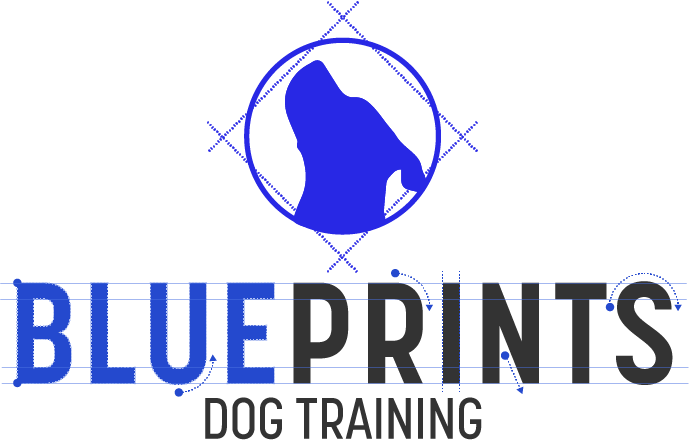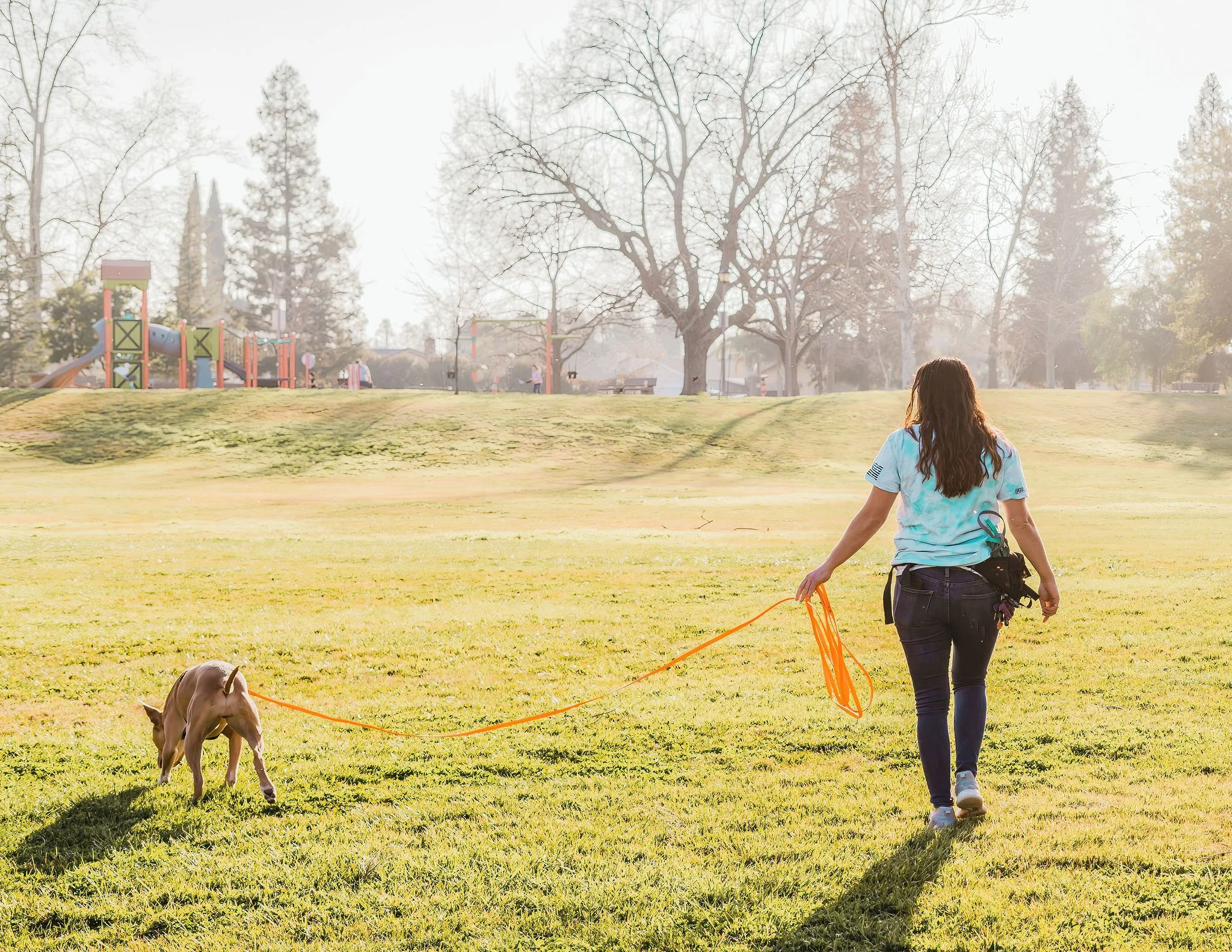Train Your Dog to Come When Called
Training your dog to come when called, also called Recall, is one of the most important behaviors to teach them. A strong and reliable recall allows you to not only bring your dog back to you but to interrupt potentially dangerous situations. Recall is more than just knowing their name. Your dog’s name has so many meanings- ‘come here’, ‘look at me’, ‘stop that’, ‘over here’, ‘take this’, ‘drop that’, etc. We say our dog’s names in so many situations and scenarios that it’s value often gets diluted.
So what is recall? Recall is a cue that we teach our dogs that means, come. Come can have different meanings depending on how it’s trained. You can request that your dog comes all the way to you, almost touching your toes with theirs. You can request that they simply come near you. It’s up to you! You can even give your Recall cue any word you want. Come is just a word, there are a million words, pick whatever you’d like. Just be sure you train it.
There are a few simple things to remember when you’re teaching your dog to come to you:
Say your Recall Cue once!
Then make it happen!
Be sure ONLY good things happen!
Get out into the world and practice!
You’ll need to start small, in spaces with low distractions before going to busy and distracting places. My dog, Cardi, loves going for walks with her long line. This allows us to practice her recall while still giving her freedom to explore spaces safely.
Remember, your cue, is just the word or sound you teach your dog. You need to take time to give this cue meaning, otherwise it’s just another insignificant word. To do this, you want to pair this word and something your dog enjoys. Using food that your dog likes is a great way to train. You can also use a toy or a game they enjoy as a reward. Humans have a tendency to repeat the cue until the dog happens to do the behavior. When we do this, the cue loses it’s value. Since we want the cue to stand out - overusing it does the opposite. Common verbal cues are: “Come”, “Here”, “Let’s Go”, and “Now”. Auditory cues might look like clapping hands or whistling. Visual cues might look like waving or kneeling with your arms wide. You can always teach a few different cues. For dogs with vision challenges, using sounds can sometimes help them better determine where their people are. Visual cues with big hand gestures might be better for dogs with hearing challenges.
Make it Happen, refers to the prompting or coaching that follows the cue and how the environment was set up. Let’s tackle prompting first. Prompting, coaching, cheerleading, encouraging - however you want to think of it, is used to get your dog back to you. For example, most dog’s love to chase, this can be used as a way to prompt your dog. Say your cue, then move away from him excitedly, when he follows, reward him. You may need to get a little silly to encourage your dog to come to you instead of have the fun they’re having. If your dog is watching the squirrels run up and down the tree and you’re standing still with a lackluster dry piece of dog kibble and the leash in your hand, you really don’t look all that exciting. In fact, you’re probably giving off the vibes that you’re there to end the fun, and for what? A piece of kibble? No thank you, sir. Maybe for a tossed toy or for my excited person who is egging me on for a game of ‘Catch Me if You Can.’ Keep in mind, the world is full of fun and distractions that humans are always in competition with. It’s incredibly important, especially while you’re beginning to teach this cue, that you reward your dog heavily, often and consistently. More on rewards later.
Now, the second part of “Make it Happen” is setting your dog up for success! That might sound a little preachy, but it truly just means, practice in environments that your dog can perform the task. You probably didn’t learn to drive on the freeway, right? Instead you were more likely to start in the driveway or a parking lot - somewhere far away from other drivers and stop lights. Only after demonstrating that you knew which pedals were which and could safely turn, did you likely venture onto a calm street. This scaffolded style learning helps to keep you and the other drivers safe. Now for your dog, this scaffolding should have a similar idea, except instead of handing him the car keys, we’re going to utilize a long lead. You must first start with teaching your dog the cue in a space where they’re calm and comfortable. If Precious won’t come to you from the other side of the kitchen, she’s definitely not coming to you from the other side of the street, or from the other side of the park. Start simple. Work inside your home, then in your yard, then when you’re out of sight inside your home, then on your walks in the neighborhood, then take it to the long line. So what’s a long line? It’s also called a long lead, training lead, lunge line, check chord, hunting lead, tracking lead or the most simple, rope. Essentially, it’s a leash that measures in length anywhere from 10’ to 50’. In general, I recommend sticking within the 15’-25’ range. More than 25’ becomes a lot of lead to handle. The long line is meant to give your dog a safe amount of freedom while allowing you to practice working on their recall.
Two quick tips about long lines:
Try your best to call your dog before they reach the end of the leash or when there’s no tension. Since the goal is to get them off of the long line, you’ll want to make sure that your cue is what they’re responding to, not the tension on the leash.
Skip the cotton leads! While cotton webbing is widely available and affordable, it can really wreck your day. By this I mean, cotton webbing leaves a mean blister behind. When managing a long line, you’re bound to wrap an ankle or get a portion yanked in your hand, take it from me- it will not be fun. I highly recommend using biothane. Many people will swear by leather lines. They’re not wrong. Leather is great and it can last forever, but it needs to be cared for properly and dogs really love chewing on leather. For the cost, I haven’t found it to be a better choice than a simple biothane lead. Biothane is a version of “vegan leather”. It’s waterproof, durable, easy to clean and doesn’t burn your hands!
Lastly, Only Good Things Happen. This is probably the most important part to understand. Countless people have accidentally ruined their dogs recall. We humans often let our dogs free to enjoy the world around them, only interfering when it’s time to go home or our dogs are about to eat something disgusting. There’s nothing wrong with allowing your dog to range and discover all the good smells, I’m an absolute advocate for allowing your dog to sniff. The trouble comes when we only call our dog to end their fun. From your dog’s perspective, they came, you said good job, put their leash on and left the park. It only takes a couple of repetitions of calling your dog in specific contexts, like near the gate or parking lot or when you have the leash in your hand, for your dog to figure out what ‘Come’ really means. Another example of this is calling our dog to do things they really don’t enjoy - like get a bath or get in the car. This further poisons their experience of the word and can even add anxiety. It’s important that something good needs to follow the recall. It doesn’t matter what you’re dog was doing before they came, they came, that’s the most important part. See dog’s are great at living in the moment, but moments are fleeting. If Luna just jumped up on a stranger but you called her and she came back to you 50 yds away - Luna deserves a cookie. If Luna comes all the way back and gets no cookie, or gets in trouble, you’ve missed a huge opportunity and made it more likely that she’ll skip out on the recall next time. When our dogs leave something exciting to come back to us, that takes effort. That effort should be rewarded. If it took them a little long to get to you or they were just trying to roll in manure before you called them, they still deserve a reward. Now, you can tell them how embarrassing, gross, stinky, naughty they are in a sweet voice while handing them a cookie, that’s fine, do what you gotta do. Just be sure you reward those good recalls!
Oh and one last thing! Forget about sit. By that I mean, Come means come to me, not Come and Sit. When you make your dog sit for their reward, you’re rewarding the sit and not the Come that they just did. If you then want them to sit, fine. In fact, I think it’s great to call your dog, reward them, ask for some other behavior or place the leash on, then take the leash off and send them back to have more fun. This makes seeing the leash in your hand or having the leash touch them much less stressful.
This is just a quick summary of the very basics. Be sure to set up a session for more coaching on ways to improve your dog’s skills!


